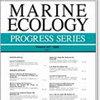通过栖息地适宜性评估切萨皮克湾蓝蟹保护区
IF 2.1
3区 环境科学与生态学
Q2 ECOLOGY
引用次数: 0
摘要
摘要:动态渔业管理要求对管理策略进行持续评估。尽管在过去 20 年中实施了各种时空捕捞和渔具限制措施,切萨皮克湾蓝蟹 Callinectes sapidus 种群的反应并不一致。为了确定环境因素是否会影响季节性青蟹禁渔区的效果,对长期(2002-2018 年)底拖网调查数据采用了广义加法建模方法,以建立整个初级产卵季节(5 月-9 月)切萨皮克湾干流成熟雌性青蟹的生态位模型(ENM)。盐度、温度、溶解氧、深度和沉积物类型是预测青蟹相对丰度的重要因素。然后,将 ENM 与高分辨率水动力-生物地球化学模型对环境协变量的后报估计值结合起来,制定栖息地适宜性指数 (HSI)。将这种基于生境的方法与基于模型的丰度指数和物种分布模型(SDM)进行了比较。尽管 HSI 的变异性较低,但 HSI 与基于模型的指数基本相似,没有明显的时间变化趋势。空间分布有明显的季节性规律,相对丰度最高的月份出现在 7 月和 9 月的下海湾,这与雌鱼向盐度较高的水域产卵有关。保护区每年保护了46-59%的良好主干栖息地,在整个海湾HSI较低的年份,保护区的表现通常较好。这些结果有助于我们了解成熟雌性青蟹在迁移和产卵期间的生态学知识,并进一步证明了保护区对成熟雌性青蟹的重要性。本文章由计算机程序翻译,如有差异,请以英文原文为准。
Evaluation of the Chesapeake Bay blue crab sanctuary through habitat suitability
ABSTRACT: Dynamic fisheries management requires continual evaluation of management strategies. Despite the implementation of various spatiotemporal harvest and gear restrictions over the past 2 decades, the Chesapeake Bay blue crab Callinectes sapidus population has not responded consistently. To determine whether environmental factors may be impacting the efficacy of a seasonal blue crab sanctuary, a generalized additive modeling approach was applied to long-term (2002-2018) bottom trawl survey data to develop an ecological niche model (ENM) for mature female blue crabs in the mainstem of the Bay throughout the primary spawning season (May-September). Salinity, temperature, dissolved oxygen, depth, and sediment type were significant predictors of crab relative abundance. The ENM was then coupled with hindcast estimates of environmental covariates from a high-resolution hydrodynamic-biogeochemical model to develop habitat suitability indices (HSIs). This habitat-based approach was compared with a model-based index of abundance and a species distribution model (SDM). HSI and the model-based index were generally similar, exhibiting no clear trends through time, though variability was lower in the HSI. Clear seasonal patterns in spatial distribution were evident, with highest relative abundances occurring in the lower bay in July and September, corresponding to the movement of females towards higher-salinity waters to spawn. The sanctuary protected 46-59% of the good mainstem habitat each year and generally overperformed in years when bay-wide HSI was low. These results contribute to our knowledge of mature female blue crab ecology during migration and spawning and provide further support for the importance of the sanctuary for mature female blue crabs.
求助全文
通过发布文献求助,成功后即可免费获取论文全文。
去求助
来源期刊

Marine Ecology Progress Series
环境科学-海洋学
CiteScore
5.30
自引率
8.00%
发文量
238
审稿时长
3 months
期刊介绍:
The leading journal in its field, MEPS covers all aspects of marine ecology, fundamental and applied. Topics covered include microbiology, botany, zoology, ecosystem research, biological oceanography, ecological aspects of fisheries and aquaculture, pollution, environmental protection, conservation, and resource management.
 求助内容:
求助内容: 应助结果提醒方式:
应助结果提醒方式:


